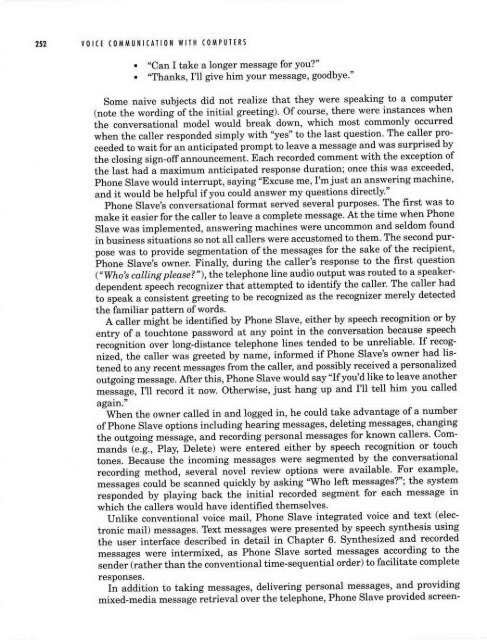MAS.632 Conversational Computer Systems - MIT OpenCourseWare
MAS.632 Conversational Computer Systems - MIT OpenCourseWare
MAS.632 Conversational Computer Systems - MIT OpenCourseWare
You also want an ePaper? Increase the reach of your titles
YUMPU automatically turns print PDFs into web optimized ePapers that Google loves.
252 VOICE COMMUNICATION WITH COMPUTERS<br />
* "Can I take a longer message for you?"<br />
" "Thanks, I'll give him your message, goodbye."<br />
Some naive subjects did not realize that they were speaking to a computer<br />
(note the wording of the initial greeting). Of course, there were instances when<br />
the conversational model would break down, which most commonly occurred<br />
when the caller responded simply with "yes" to the last question. The caller proceeded<br />
to wait for an anticipated prompt to leave a message and was surprised by<br />
the closing sign-off announcement. Each recorded comment with the exception of<br />
the last had a maximum anticipated response duration; once this was exceeded,<br />
Phone Slave would interrupt, saying "Excuse me, I'm just an answering machine,<br />
and it would be helpful if you could answer my questions directly."<br />
Phone Slave's conversational format served several purposes. The first was to<br />
make it easier for the caller to leave a complete message. At the time when Phone<br />
Slave was implemented, answering machines were uncommon and seldom found<br />
in business situations so not all callers were accustomed to them. The second purpose<br />
was to provide segmentation of the messages for the sake of the recipient,<br />
Phone Slave's owner. Finally, during the caller's response to the first question<br />
("Who's callingplease?"),the telephone line audio output was routed to a speakerdependent<br />
speech recognizer that attempted to identify the caller. The caller had<br />
to speak a consistent greeting to be recognized as the recognizer merely detected<br />
the familiar pattern of words.<br />
A caller might be identified by Phone Slave, either by speech recognition or by<br />
entry of a touchtone password at any point in the conversation because speech<br />
recognition over long-distance telephone lines tended to be unreliable. If recognized,<br />
the caller was greeted by name, informed if Phone Slave's owner had listened<br />
to any recent messages from the caller, and possibly received a personalized<br />
outgoing message. After this, Phone Slave would say "Ifyou'd like to leave another<br />
message, I'll record it now. Otherwise, just hang up and I'll tell him you called<br />
again."<br />
When the owner called in and logged in, he could take advantage of a number<br />
of Phone Slave options including hearing messages, deleting messages, changing<br />
the outgoing message, and recording personal messages for known callers. Commands<br />
(e.g., Play, Delete) were entered either by speech recognition or touch<br />
tones. Because the incoming messages were segmented by the conversational<br />
recording method, several novel review options were available. For example,<br />
messages could be scanned quickly by asking "Who left messages?"; the system<br />
responded by playing back the initial recorded segment for each message in<br />
which the callers would have identified themselves.<br />
Unlike conventional voice mail, Phone Slave integrated voice and text (electronic<br />
mail) messages. Text messages were presented by speech synthesis using<br />
the user interface described in detail in Chapter 6. Synthesized and recorded<br />
messages were intermixed, as Phone Slave sorted messages according to the<br />
sender (rather than the conventional time-sequential order) to facilitate complete<br />
responses.<br />
In addition to taking messages, delivering personal messages, and providing<br />
mixed-media message retrieval over the telephone, Phone Slave provided screen

















